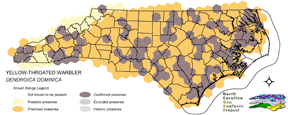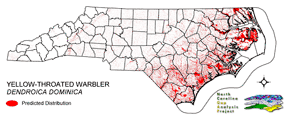
| Taxa: |
| Order: |
| Family: |
| Aves |
| Passeriformes |
| Parulidae |
| NatureServe Global Rank: |
| NatureServe State (NC) Rank: |
| G5 |
| S5B,SZN |
| Federal Status: |
| NC State Status: |
| --- |
| --- |


| Land Unit |
| US Fish & Wildlife Service |
| US Forest Service |
| US National Park Service |
| US Department of Defense |
| NC State Parks |
| NC University System |
| NC Wildlife Res. Com. |
| NC Forest Service |
| NC Div. of Coastal Mgmt. |
| Local Governments |
| Non-Governmental Org. |
| Other Public Lands |
| Private Lands |
| GAP Status 1-2 |
| All Protected Lands |
| Statewide |
| Hectares |
| 103,975.02 |
| 49,709.79 |
| 45,114.21 |
| 489.06 |
| 15,220.08 |
| 21,216.51 |
| 62,652.60 |
| 6,932.97 |
| 7,565.13 |
| 462.78 |
| 20,054.79 |
| 444.06 |
| 1,210,044.69 |
| 210,922.38 |
| 333,121.23 |
| 1,543,881.69 |
| Acres |
| 256,927.82 |
| 122,835.54 |
| 111,479.62 |
| 1,208.49 |
| 37,609.63 |
| 52,427.13 |
| 154,817.92 |
| 17,131.74 |
| 18,693.84 |
| 1,143.55 |
| 49,556.46 |
| 1,097.30 |
| 2,990,084.96 |
| 521,200.45 |
| 823,160.33 |
| 3,815,014.00 |
| % of Dist. on |
| Prot. Lands |
| 31.2 % |
| 14.9 % |
| 13.4 % |
| 0.1 % |
| 4.6 % |
| 6.4 % |
| 18.7 % |
| 2.1 % |
| 2.3 % |
| 6.0 % |
| 6.0 % |
| < 0.1 % |
| < 0.1 % |
| 63.3 % |
| ----- |
| ----- |
| % of Dist. on |
| All Lands |
| 6.7 % |
| 3.2 % |
| 2.9 % |
| < 0.1 % |
| 1.0 % |
| 1.4 % |
| 4.1 % |
| 0.4 % |
| 0.5 % |
| < 0.1 % |
| 1.3 % |
| < 0.1 % |
| 78.4 % |
| 13.7 % |
| ----- |
| ----- |
|
The bird found throughout North Carolina represents the subspecies dominica (Dunn and Garrett 1997). It breeds in the middle to lower elevations of the mountains east to the coastal plain (Fussell 1994, Potter et al. 1980) and occasionally on the barrier islands (Fussell and Lyons 1990). In the foothills of the mountain region, it is usually associated with pine stands (Alsop 1991, Simpson 1992). Elsewhere it can be found in mature (Hamel 1992) mixed deciduous-coniferous forests and in bottomlands, swamps, riparian areas, or near water, where it is often in communities of pine, sycamore, or bald cypress (Dunn and Garrett 1997, Nicholson 1997). Nest placed 20-40 feet above ground on a horizontal limb of a pine, sycamore, or cypress tree (Ehrlich et al. 1988, Pearson 1959); near the coast, often built in a clump of Spanish moss (Harrison 1975). Nests built later in the breeding season may be attached to a small, nearly vertical limb in the tree canopy (Ganier 1953). Forages high in trees (Dunn and Garrett 1997), but also along large interior limbs (Alsop 1991). NATURE SERVE GLOBAL HABITAT COMMENTS: Outside of mountains, favors broadleaf evergreen woods or bottomland forests, but in mountains usually found in pine woods or mixed forests, generally below 600 m elevation (Hamel 1992). Pine forest, sycamore-bald cypress swamp, riparian woodland, floodplain forest, live oak woodland. In migration and winter in various woodland, scrub, brush, and thicket situations, but most often in pine woodland if available (AOU 1983). NON-BREEDING: either in inland pines or coastal palms; often in areas of human habitation; prefers semi-open, old second growth, thinned woodland (Stiles and Skutch 1989). BREEDING: Nests in tree canopy, in clumps of Spanish moss if available, otherwise on horizontal branch, 3-36 m above ground. |
| Code | Name | Description | NC Natural Heritage Program Equivalent |
| 75 | Tidal Swamp Forest | Swamp tupelo dominated forest with or without black tupelo and/or cypress trees. Restricted to the tidal zones in the coastal plain. May have inclusions of coastal red cedar woodlands. | Tidal cypress - gum swamp |
| 17 | Maritime Forests and Hammocks | Maritime forests and woodlands dominated by live or sand laurel oak. Estuarine Fringe forests dominated by loblolly pine. | Coastal Fringe Evergreen Forest, Maritime Deciduous Forest, Maritime Deciduous Forest |
| 50 | Coastal Plain Mixed Bottomland Forests | Includes forests dominated by a variety of hardwood species, including sweetgum, cottonwood, red maple. | Coastal Plain Bottomland Hardwood (in part), Coastal Plain Levee Forest |
| 49 | Coastal Plain Oak Bottomland Forest | Bottomland forests dominated by deciduous oak alliances. Oaks represented can include swamp chestnut, cherrybark, willow, and/or overcup oak. Inclusions of loblolly pine temporarily flooded forests occur in patches. Hydrology is temporarily to seasonally flooded. | Coastal Plain Bottomland Hardwoods (in part) blackwater subtype, brownwater subtype |
| 158 | Coastal Plain Nonriverine Wet Flat Forests | Loblolly pine - Atlantic white-cedar - red maple - swamp tupelo saturated forests as well as forests dominated by loblolly, sweetgum, and red maple in non-riverine flats. | Non-riverine Wet Hardwood Forest |
| 41 | Peatland Atlantic White-Cedar Forest | Dense stands of Atlantic white cedar with saturated hydrology. Can include swamp tupelo, red maple, and pond pines with a moderate shrub and herb layer. | Peatland Atlantic White-Cedar Forest |
| 15 | Seepage and Streamhead Swamps | Includes extensive peat flats in the coastal plain, dominated by swamp tupelo, maples, and Atlantic white cedar alliances. In the sandhills includes streamhead pond pine and bay forests alliances. Saturated hydrology. | Bay Forest, Small Depression Pocosin, Streamhead Atlantic White Cedar Forest, Streamhead Pocosins |
| 30 | Cypress-Gum Floodplain Forests | Swamps dominated by black or swamp tupelo with or without Taxodium. Seasonally to semi-permanently flooded hydrology. | Cypress-Gum Swamps |
| 78 | Pond-Cypress - Gum Swamps, Savannas and Lakeshores | Cypress dominated swamps and lakeshores. Can include bays dominated by pond cypress or shorelines of coastal plain lakes with a narrow band of cypress. | Non-riverine Swamp Forest, Natural Lakeshores (in part) |
| 385 | Oak Bottomland Forest and Swamp Forest | The swamp chestnut oak, cherrybark oak, shumard oak and sweetgum alliance is one representative. Other alliances are dominated by water, willow, and overcup oaks. Swamp forests can be dominated by sweetgum, red maple, and black gum being dominant. Loblolly can occur in combination with sweetgum and red maple, or with tulip poplar. Includes saturated and semi- to permanently flooded forests in the mountains. | Piedmont/Mountain Bottomland Forest, Piedmont/Mountain Swamp Forest |
| 87 | Pocosin Woodlands and Shrublands | Includes pond pine woodland, low pocosin and high pocosin shrub dominated areas. Canebrakes and bay forests may be present. | Pond Pine Woodlands, Peatland Canebrake, Small Depression Pocosin |
| 384 | Piedmont/Mountain Mixed Bottomland Hardwood Forests | Includes temporarily to seasonally forests dominated by hardwood species. Hardwoods include sweetgum, red maple, sycamore which co-occur in a mosaic of bottomland and levee positions. Includes alluvial hardwood forests in the mountains. Hemlock and white pine may occur as inclusions, but are generally mapped separately. | Piedmont/Mountain Alluvial Forest, Piedmont/Mountain Levee Forest |
| 517 | Hemlock Floodplain Forest | Alluvial forest with hemlock and/or white pine in mountains and western piedmont. Hydrology is generally temporarily to seasonally flooded. | Canada Hemlock Forest |
| 527 | Appalachian Hemlock | Upland hemlock forests of the moutains region. Vary from side slopes to steep slope positions. | Canada Hemlock Forest |
| 528 | Appalachian Xeric Pine Forest | Pine forests and woodlands on xeric sites. A variety of pines, including Virginia, Shortleaf, Eastern White Pine, Table Mountain and Pitch pine. Often small areas of dense pine within a matrix of Xeric Oak-Pine Forests. | Pine Oak Heath |
| 529 | Appalachian Xeric Mixed Forest | Mixed forests with Virginia, Shortleaf, Eastern White Pine, Table Mountain and Pitch pines in combination with xeric oak species. Oaks include, white, Southern Red, black, and rock chestnut. | Pine Oak Heath |
|
Bent, A.C. 1953. Life histories of North American wood warblers. U.S. Natl. Mus. Bull. 203. Washington, D.C.
Evers, D. C. 1992. A guide to Michigan's endangered wildlife. Univ. Michigan Press, Ann Arbor. viii + 103 pp. Hamel, P. B. 1992. The land manager's guide to the birds of the south. The Nature Conservancy, Chapel Hill, North Carolina. 367 pp + several appendices. Simpson MB Jr. 1992. Birds of the Blue Ridge Mountains. Chapel Hill and London: University of North Carolina Press. Fussell, J. III and M. Lyons. 1990. Birds of the Outer Banks [pamphlet]. Eastern National Parks and Monument Association Coastal Wildlife Refuge Society. Fussell, J.O. III. 1994. A birderís guide to coastal North Carolina. Chapel Hill and London: The University of North Carolina Press. Dunn, J.L., and K.L. Garrett. 1997. A field guide to warblers of North America. Houghton Mifflin Company, Boston. Nicholson CP. 1997. Atlas of the breeding birds of Tennessee. Knoxville: University of Tennessee Press. Ganier, A.F. 1953. Observations of the Sycamore Warbler. Migrant 24:22-25. Pearson, T.G. 1959. Birds of North Carolina. Raleigh, NC: Bynum Printing Company. Harrison, H.H. 1975. A field guide to bird's nests in the U.S. east of the Mississippi River. Houghton Mifflin Company, Boston, Massachusetts. 257 p. Lack, D. 1976. Island biology illustrated by the land birds of Jamaica. Studies in Ecology, Vol. 3. Univ. California Press, Berkeley. 445 pp. Harrison, C. 1978. A field guide to the nests, eggs and nestlings of North American birds. Collins, Cleveland, Ohio. Griscom, L., and A. Sprunt, Jr. 1979. The warblers of America. Doubleday and Co., Garden City, New York. 302 pp. Harrison, H.H. 1979. A field guide to western birds' nests. Houghton Mifflin Company, Boston. 279 pp. Potter, E. F., J. F. Parnell, and R. P. Teulings. 1980. Birds of the Carolinas. Univ. North Carolina Press, Chapel Hill. 408 pp. Terres, J.K. 1980. The Audubon Society encyclopedia of North American birds. Alfred A. Knopf, New York. American Ornithologists' Union (AOU), Committee on Classification and Nomenclature. 1983. Check-list of North American Birds. Sixth Edition. American Ornithologists' Union, Allen Press, Inc., Lawrence, Kansas. National Geographic Society (NGS). 1983. Field guide to the birds of North America. National Geographic Society, Washington, D.C. Raffaele, H.A. 1983. A guide to the birds of Puerto Rico and the Virgin Islands. Fondo Educativo Interamericano, San Juan, Puerto Rico. 255 pp. Harrison, H.H. 1984. Wood warblers' world. Simon and Schuster, New York. 335 pp. Ehrlich, P.R., D.S. Dobkin, and D. Wheye. 1988. The birder's handbook:a field guide to the natural history of North American birds. Simon and Shuster, Inc., New York. xxx + 785 pp. Stiles, F.G., and A.F. Skutch. 1989. A guide to the birds of Costa Rica. Comstock Publ. Associates, Cornell University Press, Ithaca, New York. 511 pp. Alsop FJ III. 1991. Birds of the Smokies. Gatlinburg: Great Smoky Mountains Natural History Association. |
For more information please contact them at:
NC-GAP Analysis Project
Dept. of Zoology, NCSU
Campus Box 7617
Raleigh, NC 27695-7617
(919) 513-2853
www.basic.ncsu.edu/ncgap